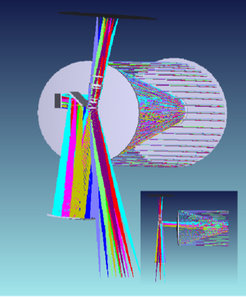Science/Instrument
Concept

Fig. 1. Basic layout of the Euclid satellite. The top panel shows the NISP focal plane, the bottom panel shows the VIS local plane.
In order to achieve the science goals of the mission, a f#20 1.2 m diameter Korsch type three mirror telescope in off axis configuration is used to generate two foci separated by the use of a di-chroic beam-splitter. The visual light channel (VIS) covers the wavelengths below 920 nm and is directly reflected from the dichroic to the VIS focal plane. The near infrared spectrographic and photometric (NISP) channel reaching from 920 nm up to 2000 nm is transferred by a relay optics to form a f#10 focus onto 16 HgCdTe HAWAII-2RG infrared detectors (Teledyne, USA). Both channels offer ≈ 0.5 square degrees of field of view (FOV). Fig.4 shows the basic layout of the Euclid satellite optics.
The instrument NISP comprises two different infrared instruments called NIS (Near-Infrared Spectrometer) and NIP (Near-Infrared Imaging Photometer). The optical design for NISP is part of MPE's hardware contribution for Euclid.
